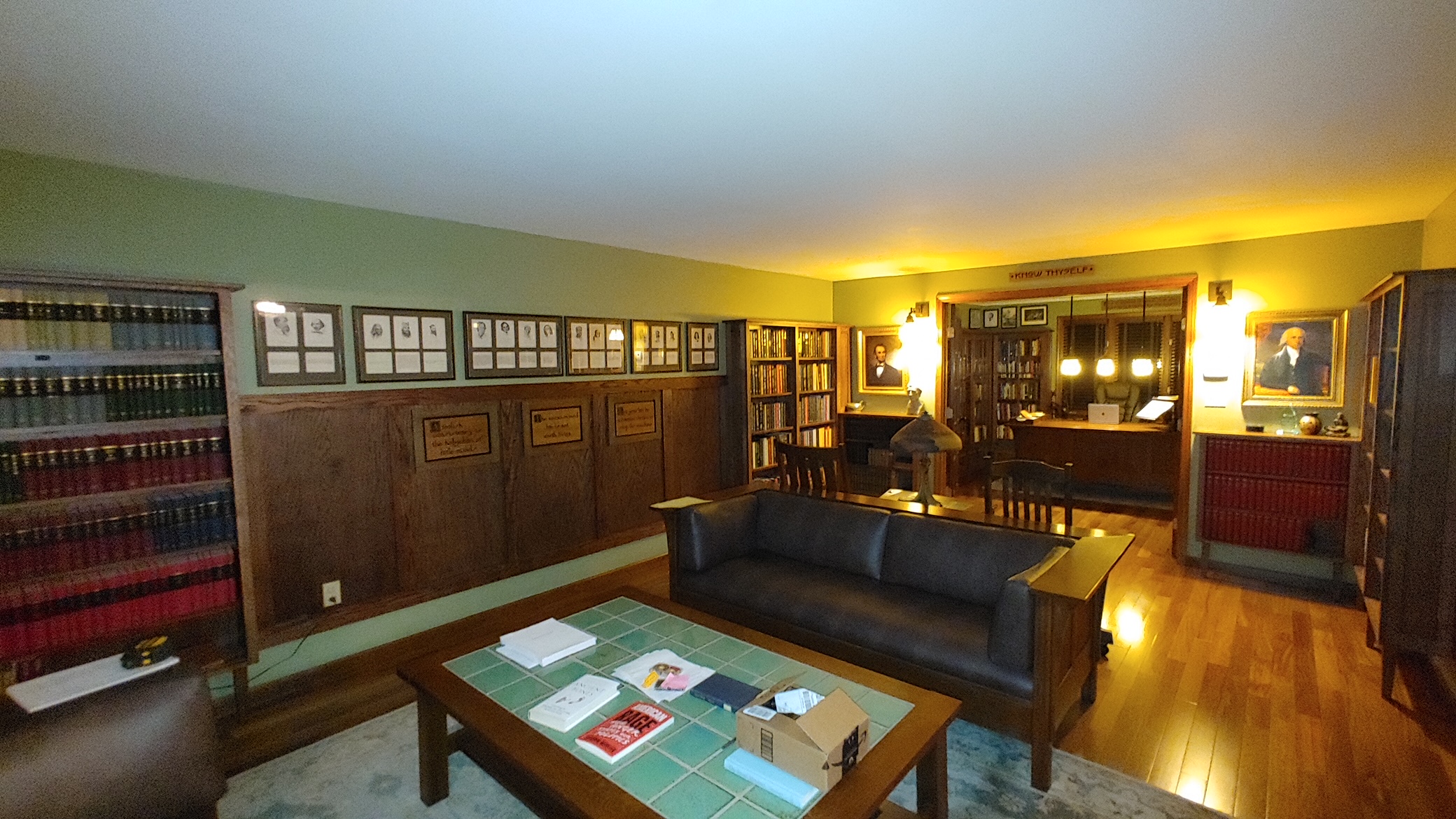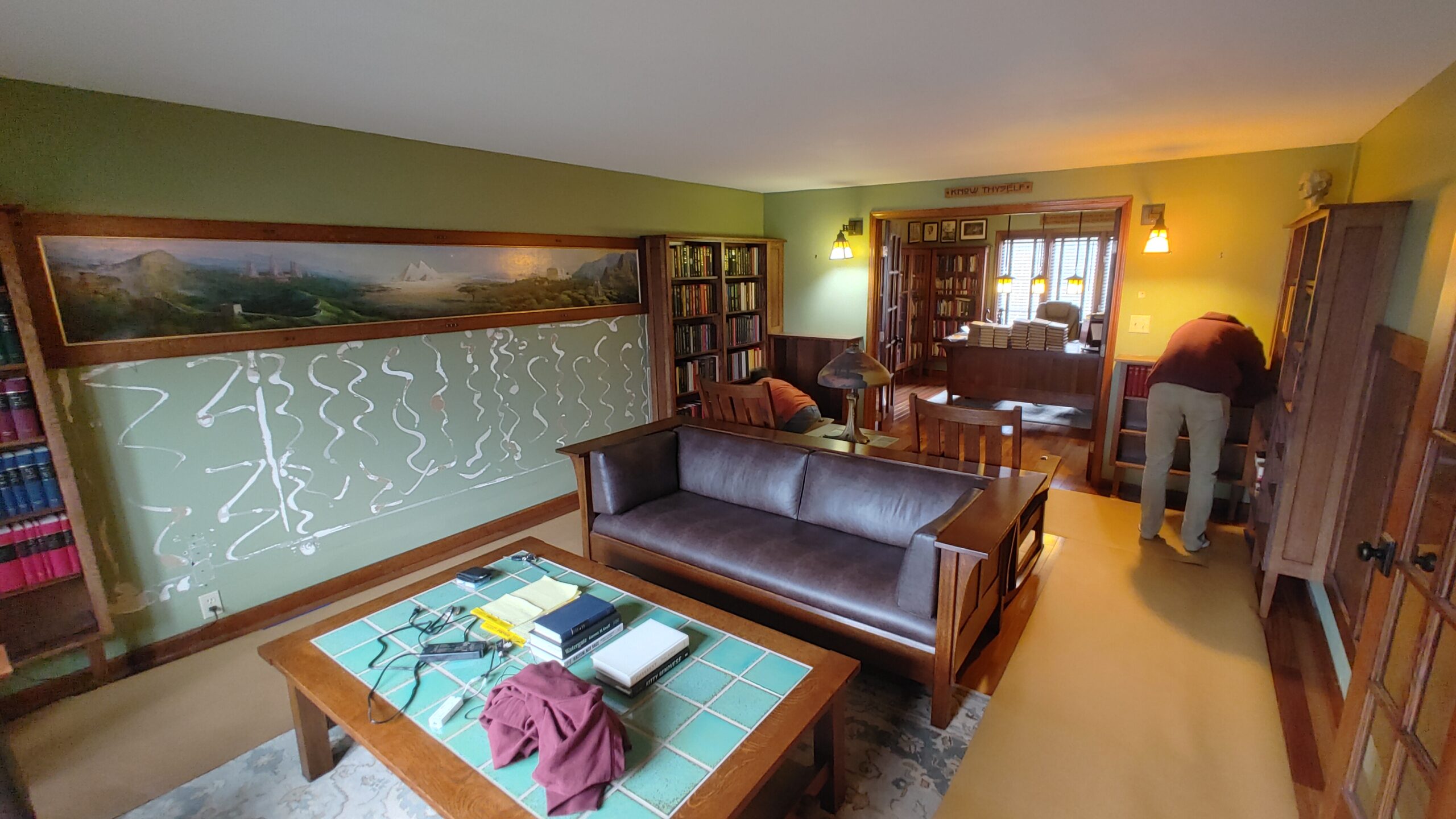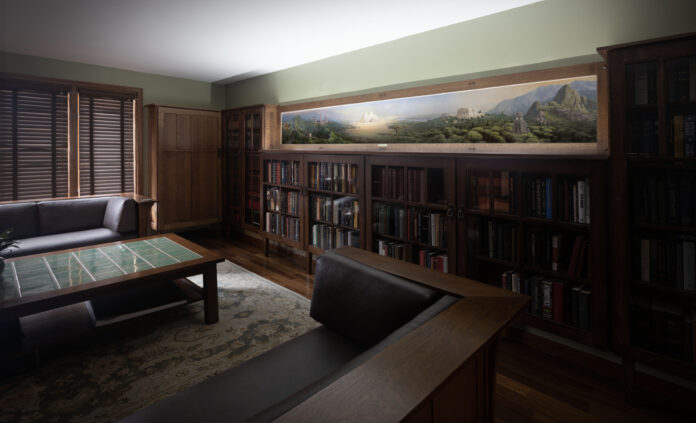This is a mural commission story that begins in East Aurora, New York. There, a community of makers has built a reputation for high-quality craftsmanship that continues with its base at the Roycroft Campus, the “birthplace of the Arts & Crafts Movement in America.”
Thomas Kegler is a contemporary landscape painter and a Roycroft Modern Master Artisan whose style drew the eye of a political scientist with an artistic vision for his home library.
When Fine Art Today saw the finished work, we had to know more. The following is our interview with Kegler, who takes us behind the scenes of this tremendous project. The mural, a landscape that incorporates historical references, was designed from the beginning to integrate seamlessly with the existing architectural elements of the room it was intended for.
Our conversation begins with the first color study and winds through the process all the way to the custom lighting and cabinets, including Thomas’s advice for artists and collectors who are interested in a similar commission.

CherieDawn Haas: I love that your client had the vision to see that he wanted a Roycroft-inspired mural in his own home. Going to the beginning of your process, tell me about the initial drafts for the project. You said you started with Photoshop and a color study, for example.
Thomas Kegler: Yes, the client had shared with me the concepts and many reference images. So I Photoshopped a rough composition by putting things inside relationships because there were so many pieces of the puzzle in this, to try to see how we were going to integrate them, and what was going to be the foreground or the background. Creating this was the easiest way to hash out a quick composition, and also be able to make very fast changes with the client based on his input.
Once the Photoshop composition was approved, then I went to the color study. It was quite small: 2 by 10 inches. It was used to work out the color scheme more than the details at that size. It let us know where the major elements were.
CherieDawn Haas: What was the conversation like when you showed him the study? Were there many changes after that?
Thomas Kegler: Most of the changes were happening in the Photoshop compositional arrangement. Once that was pretty well set, we had a good discussion on the overall mood and color concept. After I worked up the small color study, there were only a couple of small, very slight color enhancements, to help call attention to certain architectural features.



CherieDawn Haas: Tell us about the custom woodworking architectural components.
Thomas Kegler: Here in my hometown, I worked with an artist who isn’t a Roycroft artisan but works in the same vein. He’s a custom cabinetmaker specializing in arts and crafts, and quarter-sawn oak, which was a dominant feature.
CherieDawn Haas: And you mentioned that the lighting was a big part of the mural installation.
Thomas Kegler: We, the client and I, expressed the challenges of how to illuminate a 10-foot-long painting and not have hot spots and have an even light. The cabinetmaker did a little investigation and came across the solution. It’s a fairly flat system where you route a channel into the wood below the painting. You lay in a light track that goes all the way across. It’s beautiful because you can even put a soft filter on top that diffuses the light.
Being able to dial in not only the brightness and darkness, but also the temperature, was really interesting, because in the painting there are, I would say, cool passages in rainforests, and also warm passages of the desert. When you go from a warm light to a cool light on the painting, it’s amazing to see how some areas would just literally disappear and become unimportant, while other areas come into dominance. So the Egyptian section just pops and glows, and if you dial down to the cool, that just kind of dissipates, and then the rainforest comes to light. It’s really interesting to see that experience happening live.
There’s also the in-between light, which is what the client always keeps it at. So you’ve got the warm and the cool and the neutral, which is what you’re seeing in the reference photos. Usually, I paint in a fairly neutral light, so that’s the experience that he’s also getting.


CherieDawn Haas: What advice do you have for artists who may be asked to do a similar type of project?
Thomas Kegler: Commissions are kind of a dance in themselves. When you’re working with a client, obviously, the first thing you want is clarity, really good communication, and knowing exactly what the client is looking for.
I’ve worked with enough clients over the years to know that some of them are extremely open, and they really know your work and trust that. They have a vague idea, and they want you to kind of run with it and do your own thing. And then other clients can be at the other extreme, where they have a very clear vision of what they want the artist to do.
Whatever the situation is, I think it’s really important that the artist establishes clarity and communication: what services they’re offering, and having a clear agreement or a contract that outlines it (once everything has been hashed out, get it all in writing). And having clear expectations of the size and a timeline.
I always also build in space for modifications. Often my contract includes two minor modifications, and after that, the client will be billed X number of dollars per hour.
In addition to clarity and communication, it’s important to not surprise the client. Don’t just take the information they give you and then do the painting. I think it’s so important to do small preliminary sketches and color studies to show the client so that everybody’s on the same page. It’s all part of that clear communication.
CherieDawn Haas: On that note, what advice would you have for art collectors?
Thomas Kegler: Clear communication (laughs). Ask what they’re looking for, be clear, and discuss the timeframe. It’s kind of like working with a building contractor. Almost always, it takes longer than anticipated, and unusual things can arise or we build in extra time. And then if you deliver to the collector early, it just builds an even better relationship for future work.
I would say 99 percent of the time, I do come in early on the timeframe. It’s always best to leave with a good taste in the mouth on both sides. Coming in with an open mind, and also celebrating the artist’s vision, and not trying to dictate too much. Give some parameters, obviously, because it’s going to be living in your space, and you want to have a connection, but at the same time, you’re approaching an artist for a reason. And hopefully, it’s because the client has a really strong connection with past work. Look at it as an opportunity to not only celebrate the artist, but also challenge them into pushing their creativity a little bit and being open to that.
CherieDawn Haas: I agree, and I think that when people do that, it gives the artist room to surprise them in a great way.
Thomas Kegler: Absolutely. I had a really unusual one during the middle of the pandemic. I got this random e-mail from a guy in Australia. So it was a red flag that it was going to be a scam. He wanted to do a commission, so I said, “Sure.”
I usually put Bible verses with my titles, so he asked if I could do a painting based on a verse he chose. I said yes and asked what he wanted the painting to look like. He said, “Surprise me.”
This was a big painting, so it wasn’t cheap, and I thought, “This is completely a scam.” Well, to make a long story short, he sent me a check for half down. Two months later, I sent the painting to him, but he paid for it in full before I even sent it, and he loved it. What a pleasure that was, to simply have a few words as the springboard and have a client just let me run with it. You never know what you’re going to get with commissions.
CherieDawn Haas: I bet that was a dream job. I’m glad that you mentioned the titles because I was curious whether you titled this particular painting we’re featuring, and if so, what was your inspiration?
Thomas Kegler: The title is “Continuum, Isaiah 52:7.” Typically when I’m working on a painting, the final title, 90 percent of the time, comes at the end. I’ll ponder what the painting is about.
This collector had visited a lot of these places so he wanted the painting to celebrate a lot of different monuments and significant points of interest in the world. So to me, the painting was about humanity, and about society and culture.
What I typically do is search for Bible verses pertaining to the painting’s meaning, whether it’s as simple as hope, love, or whatever. The majority of the time a verse will just pop to me and say that’s the one that needs to live with that title.
How beautiful on the mountains are the feet of those who bring good news, who proclaim peace, who bring good tidings, who proclaim salvation, who say to Zion, “Your God reigns!” — Isaiah 52:7
Helpful Links:
- Visit Thomas Kegler’s website and discover his works as well as his coffee table books
- Listen to PleinAir Podcast: Episode 48, Thomas Kegler Talks Talent and Embracing Failure








